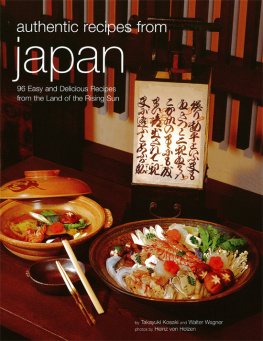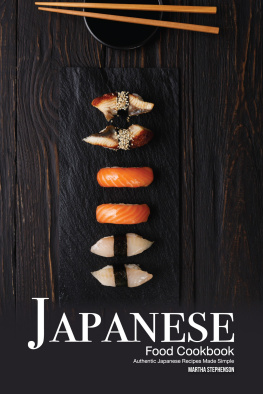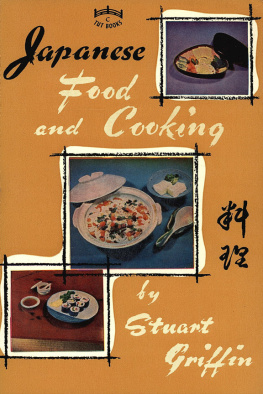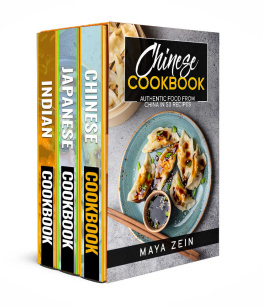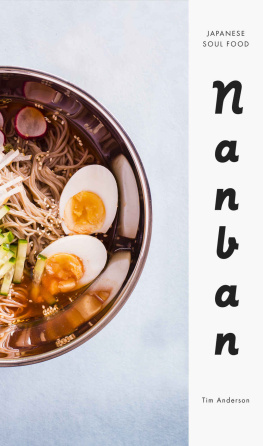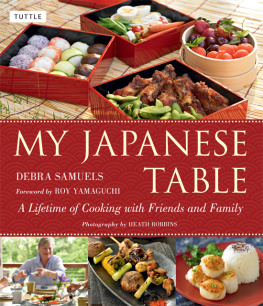Authentic Japanese Recipes
Planning a Japanese Meal
Japanese meals generally consist of many small dishes offering a range of different tastes, colors and textures. A typical meal might include a simple pickle like Pickled Cabbage, Carrot and Cucumber ( for more information).
Ingredients
The ingredients used in this book can be found in markets featuring Asian foods, as well as any well-stocked supermarket. Many Japanese ingredients are now available in the condiments and spice section of large supermarkets. When the recipe lists a hard-to-find or unusual ingredient, see pages for possible sources.
The basic ingredients needed to prepare a Japanese meal include sake, Japanese rice, mirin, dried kelp ( konbu ), rice vinegar, wasabi, nori, Japanese sesame oil and Japanese soy sauce. You may substitute Japanese sesame oil and Japanese soy sauce with the Chinese varieties, even though these do not produce quite the same result. Bonito flakes, used in dashi stockthe ubiquitous stock base for soups and saucesare another essential ingredient. If bonito flakes are unavailable, use instant dashi stock granules.
Always buy short-grain Japanese rice for an authentic Japanese meal. This variety is stickier than other long-grain varieties. As Japanese cuisine places such emphasis on the freshness of the ingredients, be sure to purchase the necessary items on the day of cooking.
Portions
Japanese meals are often served in individual portions, as main dishes and condiments are normally placed on a tray set before the diner. However, there are dishes, especially the one-pot dishes, that are consumed in a group. As a general rule, the recipes in this book will serve 4-6 people.
Basic equipment
Japanese food preparation methods are very simple, and just a few basic utensils are needed to produce an authentic Japanese meal. The essential equipment includes a rice cooker, a cutting board, a sharp knife. Japanese chopsticks (hashi) these differ from Chinese chopsticks, as they are thinner and more pointed at the endsa bamboo mat for rolling sushi ( makisu) and a Japanese grater (oroshigane). If you plan to serve Japanese food regularly, you may want to buy a set of Japanese-style tableware, which consists of plates of varying shapes, individual saucers as well as soup and garnish bowls.
Measurements and conversions
Measurements in this book are given in volume as far as possible. Teaspoon, tablespoon and cup measurements should be level, not heaped, unless otherwise indicated Australian readers please note that the standard Australian measuring spoon is larger than the UK or American spoon by 5 ml, so use 3/4 tablespoon instead of a full tablespoon when following the recipes
| Liquid Conversions |
| Imperial | Metric | US cups |
| 1/2 fl oz | 15 ml | 1 tablespoon |
| 1 fl oz | 30 ml | 1/8 cup |
| 2 fl oz | 60 ml | 1/4 cup |
| 3 fl oz | 85 ml | 1/3 cup |
| 4 fl oz | 125 ml | 1/2 cup |
| 5 fl oz | 150 ml | 2/3 cup |
| 6 fl oz | 175 ml | 3/4 cup |
| 8 fl oz | 250 ml | 1 cup |
| 12 fl oz | 375 ml | 11/2 cups |
| 16 fl oz | 500 ml | 2 cups |
| 1 liter | 4 cups |
| Note: |
| 1 UK pint = 20 fl oz |
| 1 US pint = 16 fl oz |
| Solid Weight Conversions |
| Imperial | Metric |
| 1/2oz | 15 g |
| 1 oz | 28 g |
| 11/2 oz | 45 g |
| 2 oz | 60 g |
| 3 oz | 85 g |
| 3 1/2 oz | 100 g |
| 4 oz (1/4 lb) | 125 g |
| 5 oz | 150 g |
| 6 oz | 175 g |
| 7 oz | 200 g |
| 8 oz (1/2 lb) | 225 g |
| 9 oz | 260 g |
| 10 oz | 300 g |
| 16 oz (1 lb) | 450 g |
| 32 oz (2 lbs) | 1 kg |
| Oven Temperatures |
| Heat | Fahrenheit | Centigrade/Celsius | British Gas Mark |
| Very cool | | | 1/4 |
| Cool or slow | 275-300 | 135-150 | 1-2 |
| Moderate | | | |
| Hot | | | |
| Very hot | | | |
A Portable Feast
The o-bento or box lunch is a Japanese institution which consists of white rice and an assortment of tiny helpings of meat, fish, vegetables, egg, fruit and a pickled plum (umeboshi), all arranged in a small rectangular box.
The pickled plum is believed to aid digestion and is a method of keeping the rice from spoiling. If other ingredients are not available, an o-bento may consist only of a red pickled plum planted in the center of a field of white rice; this is called a Hinomaru bento or "Rising Sun flag lunch."
Since only small portions of each food are included and a well-balanced variety of foods is necessary, preparing a proper o-bento can be a time-consuming ritual. As with almost all Japanese dishes, attention to detail and attractive presentation are paramount.
A homemade o-bento is considered a tangible symbol of a wife's or mother's love and devotion. A young husband may be embarrassed by the time and tender loving care devoted to the preparation of the lunch box known as the aisai bento ("loving wife's lunch") and be hesitant to eat it in front of colleagues. Children, less easily intimidated, glory and gloat over their lunch boxes. They compare and trade delicacies, demonstrating a sense of security and pride in the love of a mother who will wake at 5 A.M. to fry chicken tidbits, make rectangular omelets, and create panda bear and beagle faces out of seaweed and vegetables.
The most famous of the commercially made o-bento are the ekiben, the box lunches available at most of the nation's train stations. These vary greatly from one area of the country to another and are considered to be an important way of promoting regional delicacies, customs and crafts. In Takasaki, Gunma Prefecture, a region known for its doll-making industry, the lunch boxes are sold in little red plastic bowls shaped like a Daruma doll, the plastic cover resembling the face of the Daruma. It is a distinctive local touch that has made Takasaki's ekiben famous nationwide. For many travelers to Japan, tasting all the different local ekiben along their route is no less than a vital part of the trip.

Everyone enjoys an o-bento box lunchfrom school children and businessmen to Buddhist monks at a temple festival.
Mixed Chicken and Vegetable Yakitori
These skewers of grilled chicken and vegetables are very popular both in Japan and abroad.
10 oz (300 g) boneless chicken thighs, cubed
2 leeks, cut into lengths
4 oz (125 g) chicken livers, halved
8 fresh shiitake mushrooms, stems discarded and caps halved
12 small Japanese green peppers or 2 large bell peppers, deseeded and cut into strips
6 stalks asparagus, cut into lengths
36 bamboo skewers, soaked in water for 1 hour before grilling
Oil, to baste
1 portion Chicken Yakitori Glaze ()
Chicken Meatballs
10 oz (300 g) ground chicken
2 teaspoons sugar
2 teaspoons Japanese soy sauce
1 teaspoon fresh ginger juice


